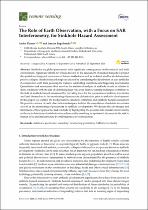 ResearchSpace
ResearchSpace
The role of earth observation, with a focus on SAR Interferometry, for sinkhole hazard assessment
JavaScript is disabled for your browser. Some features of this site may not work without it.
- ResearchSpace
- →
- Research Publications/Outputs
- →
- Journal Articles
- →
- View Item
| dc.contributor.author |
Theron, Andre

|
|
| dc.contributor.author |
Engelbrecht, Jeanine

|
|
| dc.date.accessioned | 2018-10-01T10:12:50Z | |
| dc.date.available | 2018-10-01T10:12:50Z | |
| dc.date.issued | 2018-09 | |
| dc.identifier.citation | Theron, A. and Engelbrecht, J. 2018. The role of earth observation, with a focus on SAR Interferometry, for sinkhole hazard assessment. Remote Sensing, vol. 10(10): doi:10.3390/rs10101506 | en_US |
| dc.identifier.issn | 2072-4292 | |
| dc.identifier.uri | https://doi.org/10.3390/rs10101506 | |
| dc.identifier.uri | https://www.mdpi.com/2072-4292/10/10/1506 | |
| dc.identifier.uri | http://hdl.handle.net/10204/10425 | |
| dc.description | Open access article published in Remote Sensing, vol. 10(10): doi:10.3390/rs10101506 | en_US |
| dc.description.abstract | Sinkholes are global phenomena with significant consequences on the natural- and built environment. Significant efforts have been devoted to the assessment of sinkhole hazards to predict the spatial and temporal occurrence of future sinkholes as well as to detect small-scale deformation prior to collapse. Sinkhole hazard maps are created by considering the distribution of past sinkholes in conjunction with their geomorphic features, controlling conditions and triggering mechanisms. Quantitative risk assessment then involves the statistical analysis of sinkhole events in relation to these conditions with the aim of identifying high risk areas. Remote sensing techniques contribute to the field of sinkhole hazard assessment by providing tools for the population of sinkhole inventories and lend themselves to the monitoring of precursory deformation prior to sinkhole development. In this paper, we outline the background to sinkhole formation and sinkhole hazard assessment. We provide a review of earth observation techniques, both for the compilation of sinkhole inventories as well as the monitoring of precursors to sinkhole development. We discuss the advantages and limitations of these approaches and conclude by highlighting the potential role of radar interferometry in the early detection of sinkhole-induced instability resulting in a potential decrease in the risk to human lives and infrastructure by enabling proactive remediation. | en_US |
| dc.language.iso | en | en_US |
| dc.publisher | MDPI | en_US |
| dc.relation.ispartofseries | Worklist;21384 | |
| dc.subject | Sinkholes | en_US |
| dc.subject | Geohazard | en_US |
| dc.subject | Inventory | en_US |
| dc.subject | Monitoring | en_US |
| dc.subject | Prediction | en_US |
| dc.subject | SAR interferometry | en_US |
| dc.title | The role of earth observation, with a focus on SAR Interferometry, for sinkhole hazard assessment | en_US |
| dc.type | Article | en_US |
| dc.identifier.apacitation | Theron, A., & Engelbrecht, J. (2018). The role of earth observation, with a focus on SAR Interferometry, for sinkhole hazard assessment. http://hdl.handle.net/10204/10425 | en_ZA |
| dc.identifier.chicagocitation | Theron, Andre, and Jeanine Engelbrecht "The role of earth observation, with a focus on SAR Interferometry, for sinkhole hazard assessment." (2018) http://hdl.handle.net/10204/10425 | en_ZA |
| dc.identifier.vancouvercitation | Theron A, Engelbrecht J. The role of earth observation, with a focus on SAR Interferometry, for sinkhole hazard assessment. 2018; http://hdl.handle.net/10204/10425. | en_ZA |
| dc.identifier.ris | TY - Article AU - Theron, Andre AU - Engelbrecht, Jeanine AB - Sinkholes are global phenomena with significant consequences on the natural- and built environment. Significant efforts have been devoted to the assessment of sinkhole hazards to predict the spatial and temporal occurrence of future sinkholes as well as to detect small-scale deformation prior to collapse. Sinkhole hazard maps are created by considering the distribution of past sinkholes in conjunction with their geomorphic features, controlling conditions and triggering mechanisms. Quantitative risk assessment then involves the statistical analysis of sinkhole events in relation to these conditions with the aim of identifying high risk areas. Remote sensing techniques contribute to the field of sinkhole hazard assessment by providing tools for the population of sinkhole inventories and lend themselves to the monitoring of precursory deformation prior to sinkhole development. In this paper, we outline the background to sinkhole formation and sinkhole hazard assessment. We provide a review of earth observation techniques, both for the compilation of sinkhole inventories as well as the monitoring of precursors to sinkhole development. We discuss the advantages and limitations of these approaches and conclude by highlighting the potential role of radar interferometry in the early detection of sinkhole-induced instability resulting in a potential decrease in the risk to human lives and infrastructure by enabling proactive remediation. DA - 2018-09 DB - ResearchSpace DP - CSIR KW - Sinkholes KW - Geohazard KW - Inventory KW - Monitoring KW - Prediction KW - SAR interferometry LK - https://researchspace.csir.co.za PY - 2018 SM - 2072-4292 T1 - The role of earth observation, with a focus on SAR Interferometry, for sinkhole hazard assessment TI - The role of earth observation, with a focus on SAR Interferometry, for sinkhole hazard assessment UR - http://hdl.handle.net/10204/10425 ER - | en_ZA |





